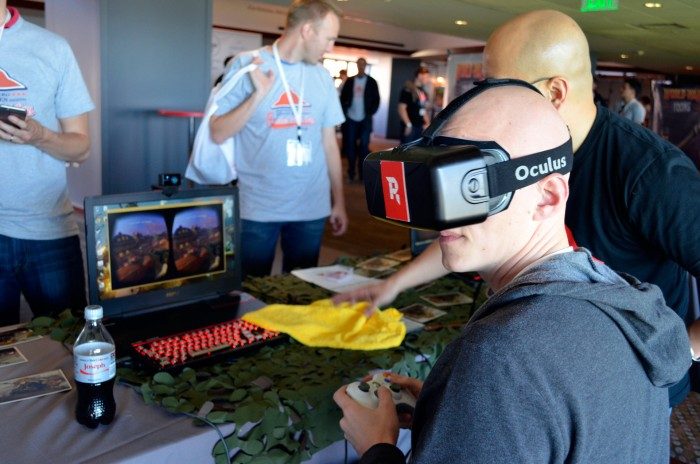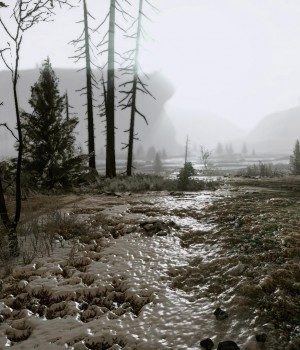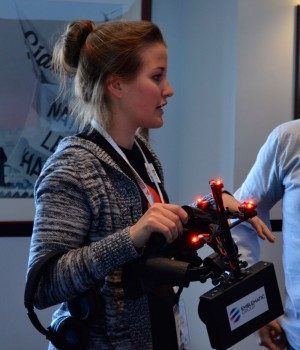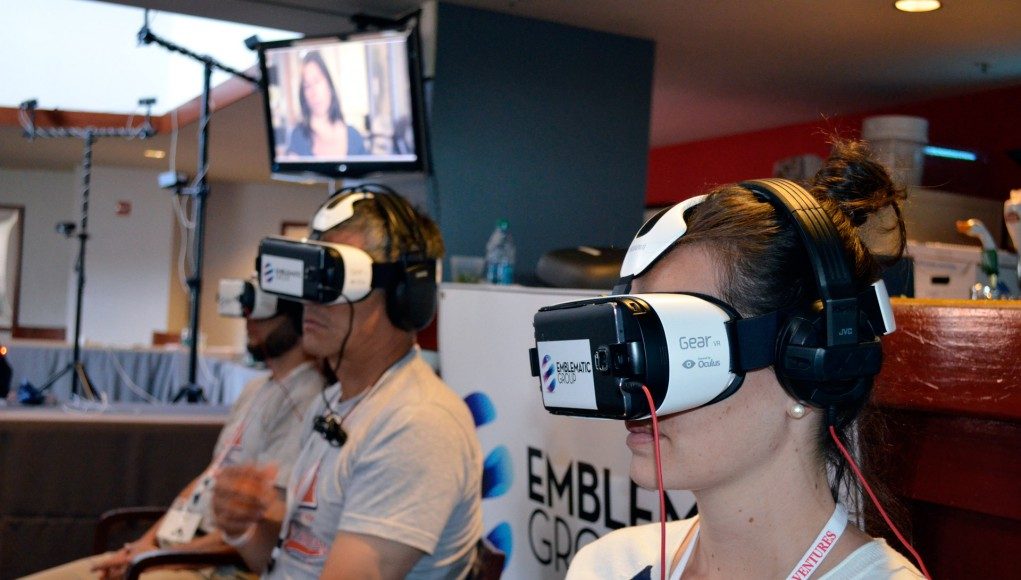The first class of Rothenberg Ventures’ ‘River’ VR accelerator have graduated. Thirteen companies, in which Rothenberg invested a combined $1.3 million, showed off their latest work at the company’s annual Founder Field Day event. Road to VR was on the scene to see what the companies had accomplished during the three month accelerator.
In December last year, Rothenberg Ventures, a venture capital firm based in San Francisco, announced plans for the first all-VR accelerator program that they call ‘River‘. The company sought to invest $1 million across 10 virtual reality startups. The three month program would provide office space and regular mentorship from knowledgeable advisors. After sifting through some 200 applicants, Rothenberg Ventures ultimately raised their ante to $1.3 million across 13 companies for the first River class.
The culmination of that first class came at Founder Field Day, an annual event hosted by Rothenberg Ventures that brings together founders, investors, strategists, and mentors for a day of networking and learning. The focal point of the event, held in San Francisco at the home of the Giants, AT&T Park, was the 13 graduating River companies. I got to speak with the founders of these VR companies and see what they’d achieved after three months in the River program. Part One of this three-part series features Reload Studios, Totwise, Innerspace, and Emblematic Group.
See Also:
- Part Two – Psious, Deepstream VR, Solirax, and Discovr
- Part Three – Fove, Triggar VR, and Vantage.TV

11 Reload Studios – World War Toons
This cartoon style isn’t restricted to looks; every player can turn into a tank at-will, giving them a temporary boost in armor and firepower. There are also jump pads around the map which launch players great distances to get them around the map quickly.
Interestingly, the three classes of soldier currently offered (Light, Medium, Heavy) fall into the opposite class when transforming into their tanks. For instance, the Light soldier turns into a very big and powerful tank, while the Heavy class turns into a small tank. This transformation seems like it will play a crucial role in World War Toons. Reload Studios COO Taehoon Oh told me that the company will offer many different tank designs for players to choose from.
The studio is also experimenting with an interesting control scheme that they hope will make the game easy to pick up, even for novice FPS players. Rather than using a joystick to control walking, forward movement is mapped to the ‘A’ button on a controller, while backward movement is mapped to the ‘B’ button. Given that the look and walk directions are mapped to the player’s head direction anyway, this actually simplifies the experience and prevents the nausea which can come from joystick-based turning.

Without the control stick to rotate the body, one major problem arises: how do you turn all the way around when you’re sitting in a chair in real life? Reload Studios is working on an interesting solution which allows players to use quick turns of their head to initiate a rotation that goes beyond their physical turning ability, while slower movements are mapped 1:1 as you’d expect. So far I’ve found the system hard to get used to, but if Reload can pull it off with continued refinement, it could be the answer to eliminating joystick turning from the seated VR experience. They’re continuously tuning this turning scheme and say that ultimately players will be able to choose if they want to use it or another more standard method of control.
Although the company says the game is still using pre-alpha game assets, the art direction is clearly a focus for the team and is coming along well. The cartoon aesthetic is consistent across the games models, animations, and even the sound design. The company is hard at work on their next build which they plan to debut at E3 in June.

22 Totwise – The Hum: Abductions
I got to check out the latest prototype build of The Hum and it’s clear that Arias and co. have a creative spark that can serve them well in the virtual reality space.
The Hum played with avatars in a narrative way that I’ve never experienced before in virtual reality. In the demo, played on an Oculus Rift DK2, I started out in the living room of a small home in the middle of the night. As I explored the room, some objects would pop up text above them as I approached to provide narrative clues (for instance, a photo which said something to the effect of ‘Me and Dan’ which showed what appeared to be a father and his young son).
As I continued to explore, I rounded the corner and saw myself—or rather, the character—in the mirror. I approached it to look at myself up close. I was a white man, maybe mid-50s, with greying hair. Provided with the context from the ‘Me and Dan’ photo, I presumed that I’m the father. The mirror prompted me to look down and see my avatar which was dressed in jeans and a brown leather jacket.
From here I followed my way down a dim hallway and into a child’s room. As I entered the door I could see cute toys scattered around the floor. A crib in the corner held a sleeping boy. Out of the bottom of my peripheral vision I saw something blue where my feet should be. When I looked down I realized that I was no longer a man, but a blue-skinned alien creature, with lean, lanky legs and creepy humanoid feet with sharp claws at the end.
This moment was unlike anything I’d felt before in VR. It wasn’t just interesting to see what it looked like to have an alien body, there was a deeper psychological switch that flicked in my head. I realized that I was now playing the role of an alien who was about to abduct this child. Against my will, I became the child’s nightmare incarnate.
This narrative use of the player’s avatar is something I’ve not seen done effectively in any other virtual reality project and I’m very excited to see what other VR-specific narrative mechanics the team comes up with.

33 Innerspace
This works well for the company as it allows for CryEngine’s impressive graphical capabilities to carry across to devices that wouldn’t otherwise be able to run it in real-time. And because the studio is focusing on narrative experiences, the interaction that would come with real-time rendering isn’t a huge priority.
But that doesn’t mean the company doesn’t want experiences with choice. Innerspace creative director Balthazar Auxietre told me that the company is working on real-time versions of their experiences for playback on capable devices like the Oculus Rift, and also considering a custom system that would allow users to make choices at key decision points even in pre-rendered versions of the experiences.
Auxietre said that Innerspace wants to become the “Pixar of VR”, working with guest directors who can come to the company to turn their vision into a virtual reality.
In addition to a few early experiences that are available on the Oculus Store for Gear VR (Like The Cave and Playhead), Innerspace is working on a new experience that explores North and South Korea’s DMZ, the demilitarized border between the two countries that’s in a state of constant uncertainty. Innerspace CEO Hayoun Kwon, told me that her upbringing in South Korea inspired her to explore the DMZ in narrative.
I got to see an early version of the Innerspace DMZ experience, which was narrated by a native Korean speaker and dubbed over in English. The experience followed the narration and opened with me entering the DMZ through a big chain link gate topped with barbed wire.
The narrator spoke of regions of the DMZ where landmines lay dormant. The imagery followed the story, slowly guiding my view through the DMZ’s mountainous terrain and dense foliage. The DMZ experience looked very good, with CryEngine’s pre-rendered visuals recreating a detailed, dense forest at dusk and night with foliage all around reacting to gusts of wind. The team told me the experience is still in development, but to my eyes it already proves an effective and detailed way to tell stories with rich visuals even on low-end hardware like Gear VR.
In addition to the DMZ piece, Innerspace is working on a real-time experience, codenamed Firebird, that targets SteamVR / HTC Vive at the top level, but will also scale from a design standpoint to seated and stationary VR headsets that lack controllers.

44 Emblematic Group
The company is using a VR system of their own creation, which includes a proprietary headset and a professional motion capture system which gives users a large space around which to roam (bigger than Vive’s ‘room-scale’ 15×15 foot area). When using the system, the wearer dons the large headset, which rests on the head using a ratcheted mounting system (like a welder’s mask), while a purse-like bag containing the hardware to power the headset is slung over the shoulder.
The company has been working with VR for several years, with founder Nonny de la Peña formerly a Senior Research Fellow at USC’s Annenberg School of Journalism and Communications where she experimented with linear narratives in virtual reality. Now that virtual reality is leaving the labs and approaching the average consumer, a growing audience may have access to de la Peña’s immersive journalism work.
“The reason we spent so much time on this recreation rather than have you watch a video or listen to the audio standing alone by itself is because of this astonishing sense of presence that this technology affords.” says de la Peña. “If we can make people understand how difficult these circumstances are, perhaps they can actually begin to think about what kind of change that they too can bring about.”
At Founder Field Day I got to step into Emblematic Groups’ Syria experience which is a real-time 3D representation of a Syrian street bustling with foot traffic, awash with the sounds of a city. After a few minutes of strolling about the scene, a bomb went off nearby, sending things into a panic with street goers shouting and running for their lives in the area now filled with dense dust and smoke. Like other experiences from Emblematic, the audio used during the scene was taken from an actual recording of the event.
While the current graphics of the Syria experience won’t impress gamers, the company says that they’re focusing on using the experience to present just the facts—as any good journalist would—without embellishment. And while the team’s graphical prowess is sure to improve, likely more important is the speed at which they can produce these experiences; another project that the company produced, which walks viewers through the events leading up to Trayvon Martin’s shooting, was produced for Gear VR in just two weeks, according to Emblematic.
Disclosure: Rothenberg Ventures covered Road to VR’s travel costs to attend Founder Field Day.



